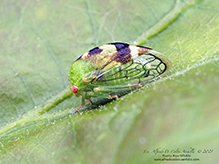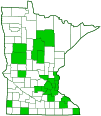treehoppers
(Cyrtolobus spp.)
Overview • Description • Distribution • Taxonomy
Adults are found in Minnesota from early May to mid-July in deciduous and mixed woodlands. They feed on the plant juices of several species of trees. In Minnesota they feed mostly on oaks, but also on American hophornbeam and hickory. In other areas they also feed on American chestnut, American sycamore, beech, and sweetgum. Cyrtolobus species have one generation per year. They are solitary and are rarely attended by ants. |
||
Description |
||
Male and female Cyrtolobus treehoppers have distinctly different forms. Within populations, there is considerable variation in both color and markings on the exoskeletal plate covering the thorax (pronotum). Nevertheless, the shape, color, and markings of the pronotum are used to identify the species. For these reasons, identifying an individual to the species level is often difficult. Females are often easier to identify than males. The pronotum is very long, extending back over the abdomen. It is only slightly inflated. When viewed from the front, it is compressed in the middle and moderately elevated. When viewed from the side, it is highest behind the humeral notch. The broad area of the wing (corium) has a cross vein connecting two longitudinal veins. |
||
Distribution |
||||
|
Sources |
|||
| 11/14/2023 | ||||
Taxonomy |
|||
Order |
Hemiptera (True bugs, Hoppers, Aphids, and Allies) | ||
Suborder |
Auchenorrhyncha (true hoppers) | ||
Infraorder |
Cicadomorpha (spittlebugs, cicadas, leafhoppers and treehoppers) | ||
Superfamily |
Membracoidea (leafhoppers and treehoppers) | ||
Family |
Membracidae (typical treehoppers) | ||
Subfamily |
Smiliinae | ||
Tribe |
Smiliini | ||
Subordinate Taxa |
|||
treehopper (Cyrtolobus acuminatus) treehopper (Cyrtolobus acutus) treehopper (Cyrtolobus arcuatus) treehopper (Cyrtolobus arizonae) treehopper (Cyrtolobus auroreus) treehopper (Cyrtolobus celsus) treehopper (Cyrtolobus cinctus) treehopper (Cyrtolobus cinereus) treehopper (Cyrtolobus clarus) treehopper (Cyrtolobus coronatus) treehopper (Cyrtolobus discoidalis) treehopper (Cyrtolobus dixianus) treehopper (Cyrtolobus fenestratus) treehopper (Cyrtolobus flavolatus) treehopper (Cyrtolobus frigidus) treehopper (Cyrtolobus fuliginosus) treehopper (Cyrtolobus funkhouseri) treehopper (Cyrtolobus fuscipennis) treehopper (Cyrtolobus gloveri) * treehopper (Cyrtolobus gramatanus) treehopper (Cyrtolobus gratiosus) treehopper (Cyrtolobus griseus) treehopper (Cyrtolobus inermis) treehopper (Cyrtolobus limus) treehopper (Cyrtolobus maculifrontis) treehopper (Cyrtolobus maxinei) treehopper (Cyrtolobus oblongatus) treehopper (Cyrtolobus ovatus) treehopper (Cyrtolobus pallidifrontis) treehopper (Cyrtolobus parvulus) treehopper (Cyrtolobus pictus) treehopper (Cyrtolobus pulchellus) treehopper (Cyrtolobus puritanus) treehopper (Cyrtolobus rufulus) treehopper (Cyrtolobus sculptus) * treehopper (Cyrtolobus togatus) treehopper (Cyrtolobus tuberosus) treehopper (Cyrtolobus vanduzii) treehopper (Cyrtolobus vau) treehopper (Cyrtolobus viridis) * treehopper (Cyrtolobus woodruffi) ----------------------------------------- * Probably a synonym of another species |
|||
Synonyms |
|||
|
|||
Common Names |
|||
None of the North American Cyrtolobus species have a common name, nor does the genus itself. The common name of the family Membracidae is typical treehoppers, and it is applied here for convenience. |
|||
Glossary
Corium
The thickened basal portion of the front wing that lies between the clavus and the membrane of insects in the family Hemiptera. Plural: coria.
Pronotum
The exoskeletal plate on the upper side of the first segment of the thorax of an insect.
Visitor Photos |
|||||
Share your photo of this insect. |
|||||
| This button not working for you? Simply email us at info@MinnesotaSeasons.com. Attach one or more photos and, if you like, a caption. |
|||||
MinnesotaSeasons.com Photos |
|||||
|
|||||

Slideshows |
||

Visitor Videos |
|||
Share your video of this insect. |
|||
| This button not working for you? Simply email us at info@MinnesotaSeasons.com. Attach a video, a YouTube link, or a cloud storage link. |
|||
Other Videos |
|||

Visitor Sightings |
|||||
Report a sighting of this insect. |
|||||
| This button not working for you? Simply email us at info@MinnesotaSeasons.com. Be sure to include a location. |
|||||
|
|
||||
MinnesotaSeasons.com Sightings |
|||||
|
|||||

Created: 11/14/2023
Last Updated:

